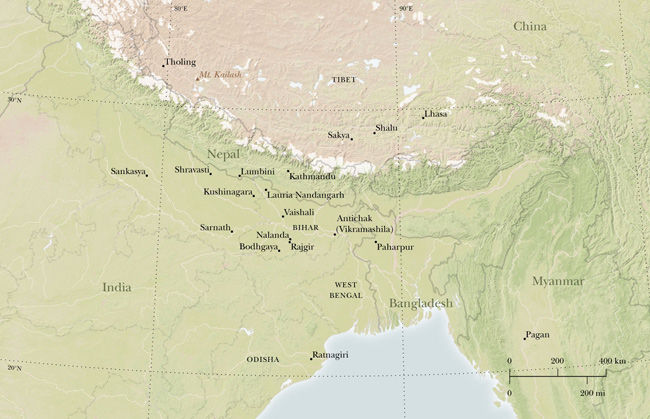This exhibition singles out two periods when the Buddhist Tibetan tradition drew from outside influences to develop new vocabularies of form. In the eleventh and twelfth centuries, after a period of political and religious disruption, contact with the great monasteries of North India led to considerable exchange. Looking from the Indian perspective, the exhibition examines how esoteric imagery, texts, and Vajrayana ritual practices contributed to reshaping the complex religious landscape of Tibet. Today, contemporary Tibetan artists are again addressing and incorporating ideas central to the current global reality, in an effort to recontextualize long-standing core Buddhist ideals. The exhibition includes five loans and eighteen objects drawn from department holdings.
The eleventh and twelfth centuries were a period of intense interaction and cultural exchange between Tibet and Buddhist North India. Like all Buddhist communities, the Tibetans strove to purify their understanding of Buddhism and thereby establish correct religious practice. As part of this effort, teachers from North India were invited to Tibet and many Tibetan monks traveled to North India to study at the famed monastic universities and pilgrimage centers associated with the Buddha's life there. Particularly important was Bodhgaya, where the Buddha reached enlightenment.
North Indian palm-leaf manuscripts, which were translated by learned monks from Tibet, were important for the transmission of artistic ideas and had an especially profound impact on Tibetan painting. By this period a more expedited path to enlightenment, Mahayana Buddhism, had emerged. This path emphasized accessible Buddhas residing in celestial Pure Lands, deities that are shown as crowned Buddhas in both North India and Tibet. Building on this foundation was Vajrayana Buddhism, described in complex texts known as tantras (hence Tantric Buddhism). These texts required deep study with a realized teacher, and the associated imagery often takes the form of fierce protectors who sweep away defilements on behalf of the devotee.
The contemporary artists Gonkar Gyatso and Tenzing Rigdol continue to grapple with giving form to elusive Buddhist notions. In this light it is interesting that the Buddha argued that the past is a fiction based on imperfect memories, shaped by one's ego, and subject to our delusional hopes and dreams for the future—a projection of time that does not exist. The Buddha teaches that the present moment is the only true reality. From this perspective, all the works presented here—even those from the eleventh century—become "contemporary" the moment a new audience encounters them. The compelling idea that these images can be understood afresh—and only in the present—is a very Buddhist one indeed.
"[A] jewel of a show"—New York Times
The publication is made possible through the generosity of the Lila Acheson Wallace Fund for The Metropolitan Museum of Art, established by the cofounder of Reader's Digest.

Many places in North India were made sacred by the historic actions of the Buddha. The most important places of pilgrimage are Bodhgaya, where the Buddha reached enlightenment, and Sarnath, where he taught the first sermon. Also important are the huge monastic complexes of Nalanda and Vikramashila. When the Indian monk Atisha traveled to Tibet in 1042, he stayed in Kathmandu before traveling to Tholing in western Tibet. He ultimately came to central Tibet and stayed at Shalu and several other places before his death in 1054.
The following objects are on display in gallery 251.
The following objects are related to those in the exhibition but are displayed in our permanent-collection galleries. All appear in the winter 2014 Met Bulletin, Tibet and India: Buddhist Traditions and Transformations.
Twelve-Armed Chakrasamvara and His Consort Vajravarahi (detail), ca. 12th century. India, west Bengal or Bangladesh. Phyllite; H. 5 in. (12.7 cm); W. 3 1/8 in. (7.9 cm); D. 1 1/2 in. (3.8 cm). The Metropolitan Museum of Art, New York, Gift of Mr. and Mrs. Perry J. Lewis, 1988 (1988.392)